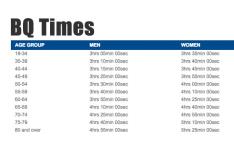What matters is how long it takes to run the distance, not the distance itself.
Types of Lactate-Threshold Workouts
I typically use four types of lactate-threshold workouts:
- Continuous runs at lactate-threshold pace, starting at about 3 miles (15 to 20 minutes) and increasing up to 7 to 8 miles (about 45 minutes) for marathoners
- Intervals run at lactate-threshold pace with short rest periods, such as 4 x 1 mile at lactate-threshold pace with 1:00 rest or 8 x 1,000 meters at lactate-threshold pace with 1:00 rest
- Shorter intervals run at slightly faster than lactate-threshold pace with very short rest periods, such as 2 sets of 4 x 1,000 meters at 5 to 10 seconds per mile faster than lactate-threshold pace with 45 seconds rest and 2:00 rest between sets
- Medium-long distance runs with a portion run at lactate-threshold pace, such as 12 to 16 miles with the last 2 to 4 miles at lactate-threshold pace or 2 miles + 3 miles at lactate-threshold pace + 6 miles + 3 miles at lactate-threshold pace (I only use these latter workouts for marathoners).
As you progress, increase the training load by spending more time at lactate-threshold pace rather than by running faster. You can do this by increasing the volume of a single workout or by adding a second lactate-threshold workout each week. Only increase the pace of the workouts once your races have shown that you are indeed faster. See the lactate threshold training chart for a sample training program.
If you want you to perform at the highest level you can, train your lactate threshold—you'll soon be on your way to achieving new personal records at longer distances.
- 2
- of
- 3
About the Author

Get ACTIVE on the Go


13.one Half Marathon
Get expert advice and guidance as you progress in your journey to becoming an avid runner.
Available for iOS







Discuss This Article